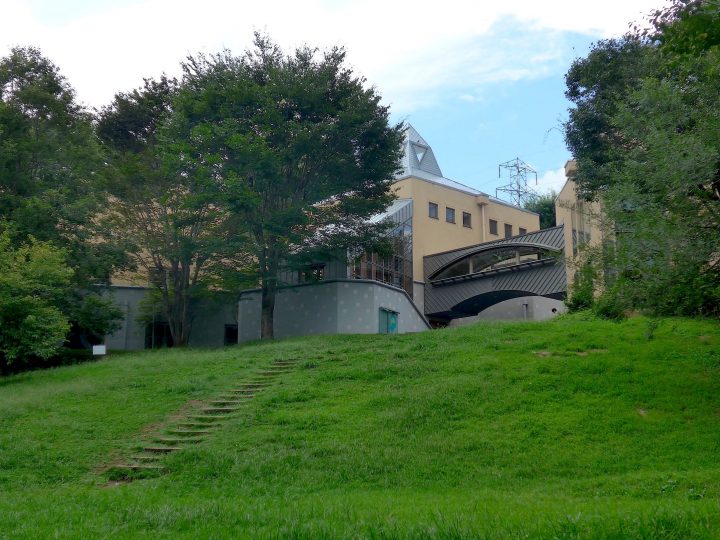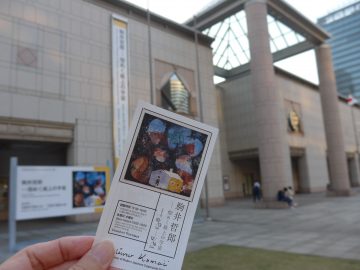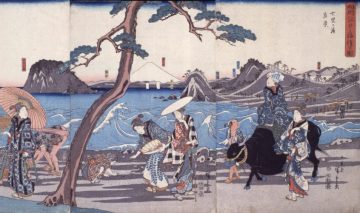People Landscape in KANAGAWA | Lighting up an abandoned school with the art festival "Hikari Matsuri" - learning sustainable community activities from Fujino Town
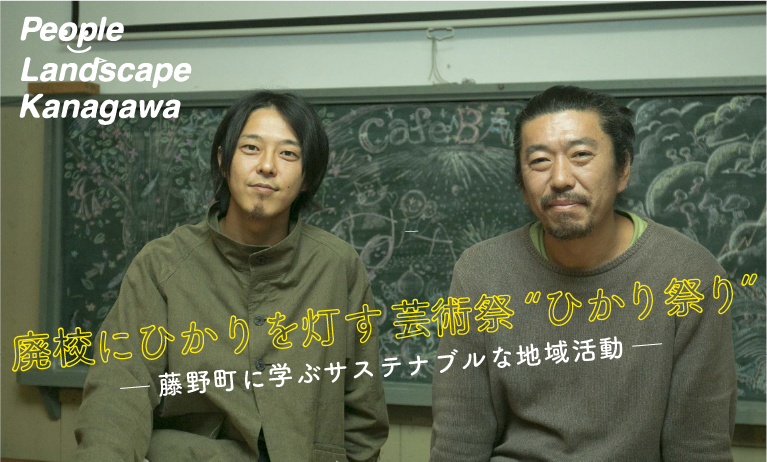
Interview & Text: Akiko Inoue Photo: Masamasa Nishino
I first learned about Fujino Town (currently Midori Ward, Sagamihara City) when I was invited by a friend to visit the Hikari Festival three years ago. At the same time, some people around me were talking about the festival, so I went there in a car with one of them. The Hikari Festival, held at the former Makigo Elementary School, which had been closed due to depopulation, cannot be described as a music festival or an art festival. It is more like a special occasion for local residents, or a festival, and stands out among the many festivals out there. And above all, I was shocked to find out that Fujino, an unknown rural mountain area, is located in the northwestern tip of Kanagawa. Since then, the town's charm has been introduced to a certain segment of the public, little by little, with a feature being published in Spectater , a magazine known for its unique perspective.
Through these experiences, I learned that there is a group called "Transition Fujino" in the town, which has fostered a spontaneous community in pursuit of a sustainable lifestyle and is tackling various issues. I would also like to add that the movement that emerged from this, such as "Yorozu local currency," the little press "Fujinobon," and "Fujino Electric Power," further highlight the identity of the town. This time, encouraged by the mysterious charm of Fujino, we interviewed photographer Kazuhiko Hakamada and Den'etsu Odajima of Fujino Electric Power, triggered by the "Hikari Festival," also known as a festival that uses 100% natural energy.
Location: Makigo Lab (former Makigo Elementary School) Fujino Electric Power Office
*Due to municipal mergers, Fujino-cho is now part of Midori-ku, Sagamihara City; however, within this article we will consistently refer to it as Fujino-cho, the long-standing name familiar to locals and those who know the town.
The beginning of the "Hikari Festival," an art festival that brings a ray of hope to an abandoned school
- First of all, please tell us how the Hikari Festival started.
Kazuhiko Hakamada (hereinafter H): None of the current members running the Hikari Festival have been involved since the first festival. So I heard this story from Tsutomu Shimada and his team, who started the festival, but after Makigo Elementary School was closed, Tsutomu and his wife Naoko established the current Makigo Lab (an art space and shared atelier). However, the locals only had the impression that an artist had come from Tokyo and started something, so they started the Hikari Festival with the intention of making their activities known to more people.
- This school building was reused as Makigo Lab in 2003, and the Hikari Festival began in August 2004. Could you tell us a bit more about how Makigo Lab got started?
Odashima Densetsu (hereinafter O): It seems that Chikara and his team had been looking for places where artists could stay and create their work, not just in Fujino, but when they came across this former Makigo Elementary School, they fell in love at first sight. I imagine that they must have climbed the slope leading to the schoolyard on a sunny afternoon, and been enchanted by the sight of the pink school building and the scenery that suddenly spread out before them. I think they said that they somehow managed to convince them to come.
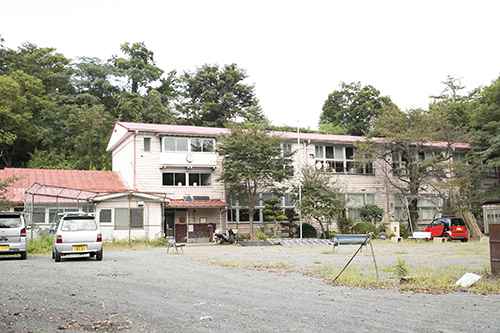
Makigo Lab (former Makigo Elementary School), the venue for the "Hikari Festival"
O: Originally, this elementary school wasn't built by the government, but by local people out of necessity. The land was provided by someone, the building was built by everyone, and the teachers were found and run by people from within Tokyo. It was a completely handmade elementary school. In other words, it was an extension of a temple school.
H: Apparently the building was blown away in the Ise Bay Typhoon in 1934, but at that time classes were actually held in a nearby temple.
- Is that so!
O: So this building is the second generation. It's already 55 years old.
- By the way, what is the origin of the name Hikari Festival?
O: This is also a rumor, but isn't it because most of the artists there were working with light?
H: Maybe it was influenced by the fact that the founder, Chikara-san, is also a video artist, and that there were many lighting artists among his colleagues. But apart from the image of a light show, the underlying theme has always been "lighting a ray of hope in an abandoned school."
- I see. "Hikari" is an abstract word, so it can be interpreted in many different ways. What kind of artists and groups are currently using Makigo Lab?
O: The room I'm in now is the Fujino Electric Power office. Other members include a guitarist, a team called OVERHEADS that does light shows, an NPO called Nature Childcare Friendship Association, a space designer, and a sound artist. As for what we're doing, we're all doing what we like (laughs).
H: There is the base that I just mentioned, but I think there are many people who do a variety of other things as well.
- So the "Hikari Festival" is a mix of them, artists invited from outside, and local people. Is there anything that has changed since the early days?
H: The scale is getting bigger and bigger, but the style hasn't changed much. At first, admission was free so that local people could easily come, but as it got bigger every year, it became too much to handle with free admission. (※Admission fee is 3,500 yen for all three days)
- Still, it's a bargain! I remember being surprised at first that you can enjoy 3 days for this price!
O: Right? (laughs)
H: We were told that it would be a little easier if we made it a little higher, but just couldn't help it...
Odashima's encounter with Fujino Town
O: The first time I came to Fujino was for the Hikari Festival.
- What was your first impression?
O: I found a flyer at a record store in Tokyo and went there, and I was really surprised. At that time, most festivals were pretty much what you'd expect, but the artists at Hikari Festival were people I'd never heard of, and I didn't even know this town existed, so I got interested and took my wife and kids there. Then, an old man was singing in the elementary school playground... (laughs) By the way, that old man was Shigeru Yokoyama of Siegel-do.

A former pharmacy renovated into an art showroom
- Wow, that's shocking...! Was this experience what prompted you to move from Tokyo to Fujino?
O: It wasn't an immediate decision to move, but it was a big turning point.
By the way, on the way home that day, we were having trouble finding a bus back to the station, and a car appeared in the darkness, and an old man gave us a ride to the station, even though we didn't know each other. Then, we missed the last train at the station and were at a loss again, when a man, also a passerby, came to pick up his daughter at the station and offered to take us to a nearby inn, and gave us a ride. Meanwhile, the girl came from the station and got in the passenger seat, but she didn't pay us any attention and kept talking about what happened that day, and it wasn't until we got home and got out of the car that we asked, "By the way, who are these people?" (laughs) We explained the situation, and the girl said, "Well, goodbye," and left. When I saw that, I thought, "How natural." So that series of impressions from my first time in Fujino is burned into my mind.
- How long did it take between that incident and when you moved?
O: About four years.
After that, we would go for drives on our days off, and since my wife was influenced by the ideas of Rudolf Steiner, we would go and see Steiner schools . Apart from that, we were living with my wife's parents at the time, so we decided it was time to move out and started looking for a house. However, we didn't immediately choose Fujino, and we looked in Okinawa and Ibaraki, and just when we were hitting a dead end, my wife suddenly found a house in Fujino on Yahoo! Real Estate, and said it was cheap, so we went to see it, and we ended up deciding on it.
- There were a lot of twists and turns, but in the end it felt like Fujino was calling me.
O: Yes, that was the feeling I got.
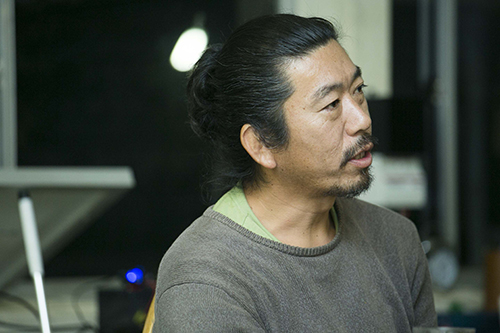
Hakamada-san and Fujino's encounter
- So, please tell us what led you to move to Fujino.
H: In my case, it wasn't long before I discovered Fujino and moved there. The first time I came to Fujino was when I had just become a photographer from an assistant in Tokyo, and a friend invited me to Fujino to listen to UA's live performance.
- That was when UA was still living in Fujino. How many years ago was that?
H: About seven years ago. We had a concert at "Cafe Restaurant shu" , and I remember thinking, "Why such a small venue?" In the middle of the concert, UA said she had to go home because she had kids (laughs). There were a lot of Fujino's friends in the audience, and there was a lot of back and forth between UA and her, and I thought, "Wow, this concert is so fun."
- What a luxury!
H: It was so much fun that I remember chatting with the owner, Shu, after it was over.
I had just started thinking about living in the countryside, and two months later, I decided to end my life in Tokyo, although that wasn't the trigger. I was looking for a place to have a farm, so I searched for two words I knew at the time: "Permaculture" (a design system for creating a permanent and sustainable environment for humans. Permanent + Aguriculture) and "Woof" (a system of exchanging "food and lodging", "power" and "knowledge and experience" without exchanging money). I found a place in Azumino, Nagano, where I could do what I wanted, and called there. However, it was winter and there was no one there, so I couldn't get through no matter how many times I called... Then, another friend invited me to go to Fujino, and I stopped by Shu's shop again.
- So this is your second visit.
H: Right. At that time, Shuu was pulling out radishes and handing them to UA, but we were watching the exchange between the two of them, who were saying things like "I can't take that much home," from our seats. Then Shuu and I made eye contact and he asked me, "Do you want some radishes?" (laughs) I said, "Oh, okay..." and he gave me some, and that was my reunion with Shuu. From there, I told him how I wanted to do farming, and jokingly said, "I want to work here," and at first he said, "I can't pay you a salary," but in the end he asked, "So when are you coming?" (laughs)
So I started helping out the day after tomorrow, and ended up living there for about two and a half years. That was the reason I decided to move here. There, I learned farm work from Shu, heard interesting stories at night, and was introduced to many people. I was more shocked after I came here than before.

- For Mr. Hakamada, things progressed smoothly (laughs). But from what you two have said, I could sense the lack of caution and tolerance of the people of Fujino in a good way. How did the Hikari Festival and Mr. Hakamada get connected from there?
H: Shu's shop set up a stall at the Hikari Festival, so I also participated as a vendor at the 5th festival. That was the very beginning. After that, I started to get involved in the management of the 7th festival, when Chikara, the initiator, graduated from the festival.
What is Fujino Electric Power?
※ Fujino Electric Power website
-By the way, is it correct to say that Mr. Odajima is the representative of Fujino Electric Power?
O: Fujino Electric Power is not an organization like a company, it's just a team of people who like each other and come and go.
- Is it like a club?
O: That's right.
- There are many different types of natural energy available. Why did you choose solar power generation?
O: There was no selection process. We were talking about how it would be nice to generate our own electricity, so we searched online and found solar panels for sale. There were other options, but they were too expensive for us to just click and buy. But solar panels were something we could just click and buy.
- I heard that all the electricity for the Hikari Festival and Makigo Lab is provided by Fujino Electric Power's natural energy sources.
O: First of all, the Hikari Festival has been 100% self-generated since the 8th festival. But saying that it was powered by Fujino Electric Power has a different nuance. What Fujino Electric Power did for the Hikari Festival was just to coordinate the layout of the power sources at the venue, and there was another person who brought the power source, so many different people were involved. In fact, we only realized this recently, but it seems that the Hikari Festival has been self-generated, although not 100%, since the first festival.
H: It just wasn't announced in a big way.
O: We didn't do the deliberate step of turning off the breakers in the school buildings and gymnasium and switching to our own electricity, but we did use renewable energy for all the additional power sources.
- I see. There has been a new generational change, but that mindset has been naturally shared. I think that's actually amazing. By the way, when I went around Fujino today, I saw charging stations everywhere. I think that's one of the activities of Fujino Electric Power, but what was the purpose of creating them?
O: Going back to how it all started, we were given a lot of old, second-hand solar panels. We started a project to make the Makigo Lab 100% self-powered as a way to utilize them, but let me say right off the bat that it hasn't really gone well, and to be honest, we're at a dead end right now... We found that the amount of power generated was less than expected, and the battery was empty after three days, and if we kept running it in that state, the battery would wear out. So we haven't yet achieved 100% self-powered for the Makigo Lab.
But the reason I first thought of making the lab self-powered was that, first, it could become an evacuation site for local people in emergencies like earthquakes, and second, I thought we could do something interesting if everyone could use the surplus electricity during normal times. One of the ways to use it during normal times is as a charging station. If there is one in a major hub where people gather, people who come to play on electric bicycles or motorcycles can charge their bikes while they have tea, and that's how it started.
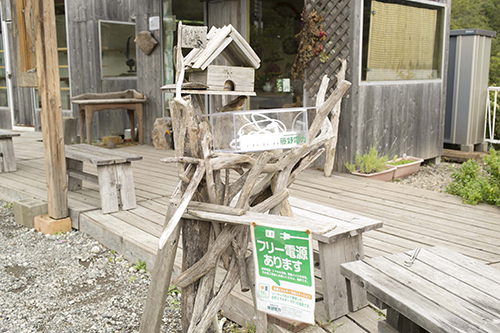
Charging station inside Fuji Art Village
*Currently, there are four charging stations in Fujino (Fujino Art Village, Village 2 Sunhills, and Niren Cafe)
They are installed at Tekuteku Shinobara no Sato. You can also charge your cell phone there, so please make use of it!
- Mr. Odajima, you originally worked in a field unrelated to electricity. What led you to take the reins at Fujino Electric Power?
O: There were two steps to it. In 2008, Transition Town activities started in Fujino, and among the various activities, there was a group that started saying, "Let's generate our own electricity." I thought this sounded interesting, so I quit my job as Moribe, who was the head at the time, and joined that group. That's how it all began.
- So it was Moribe's manager...! So it started out of pure interest?
O: That's right. Actually, at first I was consciously trying not to get caught up in the Hikari Festival because it seemed like such a big deal (laughs). But gradually I started to get caught up in it, which is the other step I mentioned earlier.
The 8th Hikari Festival was held using 100% renewable energy
O: Up until the 7th event, I was a customer, and I maintained the stance of helping out where I could, and at first, even at the 8th event, I just went and listened from a distance, thinking, "Hmm..." But that year was the year the earthquake happened, and I was wondering what to do at the discussion meeting.
H: That's right. After the disaster, some members evacuated to Kyushu, some stayed in Fujino, and some went to Tohoku, and we continued to watch the situation in Fukushima with no end in sight... But somewhere in the back of our minds, we were all thinking about the Hikari Festival... That's how it felt. Then, on the mailing list, a message from Chikara came through, and I think everyone was inspired by the words and started to move.
O: That's right. At that time, we were talking about 100% self-powered electricity, but I hadn't said that I would do it.
H: But we were told that if we were to do this, we absolutely needed to appoint someone.
O: I remember that after the meeting, an email came in asking if anyone wanted to do it. When I read it the next day in the smoking room at work, I impulsively thought, "Oh, I want to do it." But at the same time, I also felt like, "This is bad." I intuitively felt that if I volunteered, I wouldn't be able to balance it with my work. So I decided to wait a week to consider both of these feelings before making a decision. So a week later, I still had made up my mind, so I thought, "Okay, then let's do it!" and replied, "I'll do it."
- You had previously kept aloof from the Hikari Festival, but now you have decided to get fully involved. What motivated you to do so?
O: For me, the reason I chose this lifestyle wasn't because of electricity, but because of festivals. I was really fascinated by the way the people who make festivals shine. I also had a strong admiration for the performers and backstage staff, wondering what was going through their minds as they stood on stage. Then electricity came into play, and without electricity the backstage staff's machines wouldn't work, and the performers wouldn't make any sounds... I was really excited by that kind of relationship. From there it just went with the flow, and as expected I ended up quitting my job, and as expected it was difficult...
- As expected (laughs)
H: There are a lot of people who have changed a lot because of the Hikari Festival. In my case, I'm single, so I can do whatever I want, but when Tetchan (Odajima-san) raised his hand, honestly, everyone was like, "Wow, Tetchan made a decision..." (laughs)
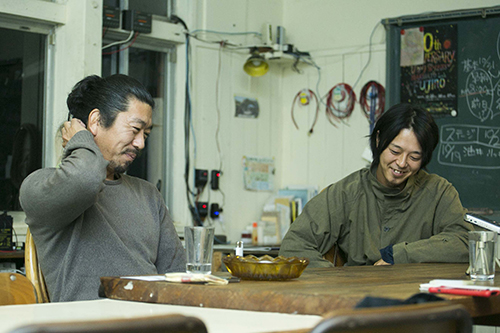
- But in other words, it has an appeal that is just as impressive.
O: Yes, there was a proud charm to that role at that moment.
- Ultimately, your goal of holding the festival using 100% renewable energy was achieved.
O: At first, there was a lot of resistance within the Fujino Denryoku team to getting involved in the Hikari Festival, and I was the only one who showed up at the festival, working hard on it alone. But gradually, the activities of the Hikari Festival and Fujino Denryoku overlapped naturally, and on the day of the festival, my colleagues from Fujino Denryoku volunteered here and there. So when the festival was over, it felt natural to say, "Fujino Denryoku was the power source for the Hikari Festival."
Fujino Town was an evacuation site during the war, but what is its appeal as a place where artists gather?
- I heard that Fujino was the place where Transition activities first started in Japan. How did "Transition Fujino," the movement that gave birth to Fujino Electric Power, come about?
O: A man named Hidetake Enomoto happened to be in the Transition Town movement , which was born in a small town called Todnes in the UK. The experience reminded him of Fujino, so he brought it back to Fujino and started this movement.
- So, like the Hikari Festival and Transition activities, various things have flowed in from the outside and gathered there, forming the Fujino we know today. That may have something to do with the fact that Fujino was an evacuation site during the war. I heard that a dozen painters and sculptors, including Tsuguharu Foujita, Genichiro Inokuma, and Kazuo Wakita, lived as evacuees there. The fact that Fujino is tolerant of things that flow in from the outside without resisting them may also be one of the reasons why it exists today.
O: Leonard Foujita and the other evacuated group were considered the first generation, and broadly speaking, we are considered the fourth generation.
- I see. Recently, art festivals have been held all over Japan, but what's happening in Fujino Town has a mysterious charm that doesn't fit into any of them. How do you two feel about it as people involved?
H: When I made a promotional video for Fujino Town, I interviewed Jun Sato (an artist who is considered the elder of Fujino) to find out why Fujino is known as a town of art. In the absence of tourist attractions, the only way to revitalize the town was through art, and the local government provided money to create an "art road," and there were many other plans. However, according to Sato, these were looked upon rather coldly. But then, at one point, an organization called Art Sphere, which provides grants for the arts, was formed, and the first thing they did was to bring together artists living in Fujino.
- I see. The first Art Sphere art festival was held in 1988.
H: Until then, each person had been creating their own work while enjoying their daily lives, but this opportunity allowed them to connect with various people in Fujino. He said that it was great that these encounters led to connections such as "Wouldn't it be interesting to do something like this?" After all, when people connect with each other, become friends, and something great is born from that, I think that this is something that can be applied to the Hikari Festival.
O: Yes. I think that's it. What's great about Fujino is that the connections between people extend to every aspect. Also, everyone is able to respect others, connect with each other on a genuine level, and have the strength to work without rejecting others.
H: Also, when I casually say, "I want to try this," the older people say, "Go ahead and do it!" And that kind of feeling is passed on to the next generation.
- Listening to your story, Fujino seems even more attractive to me. Finally, do you have any words of advice for people who have not yet visited the Hikari Festival?
H: This festival is held at an elementary school that is important to the men who attended Makigo Elementary School, so as we have been involved with them from the preparation stage, we have come to love this school more and more with each passing year. So I hope that this feeling can be conveyed to the people who come. Also, people who come often say things like, "The nature here is really nice" or "The vegetables are delicious," and I think it is important that visitors notice the charms of Fujino that locals usually don't notice.
O: I'm sure they love it. The local men love it too. They really enjoy having people gather there, making it lively, and making them happy with the food they give out.
I'm sure you'll find someone or something that will make you feel comfortable! I think it would be great if you came and visited.
- Thank you.
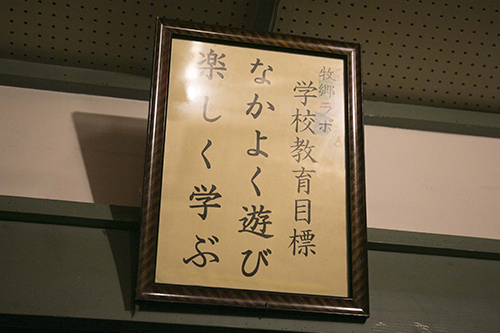
A slogan displayed in a classroom at the former Makigo Elementary School
